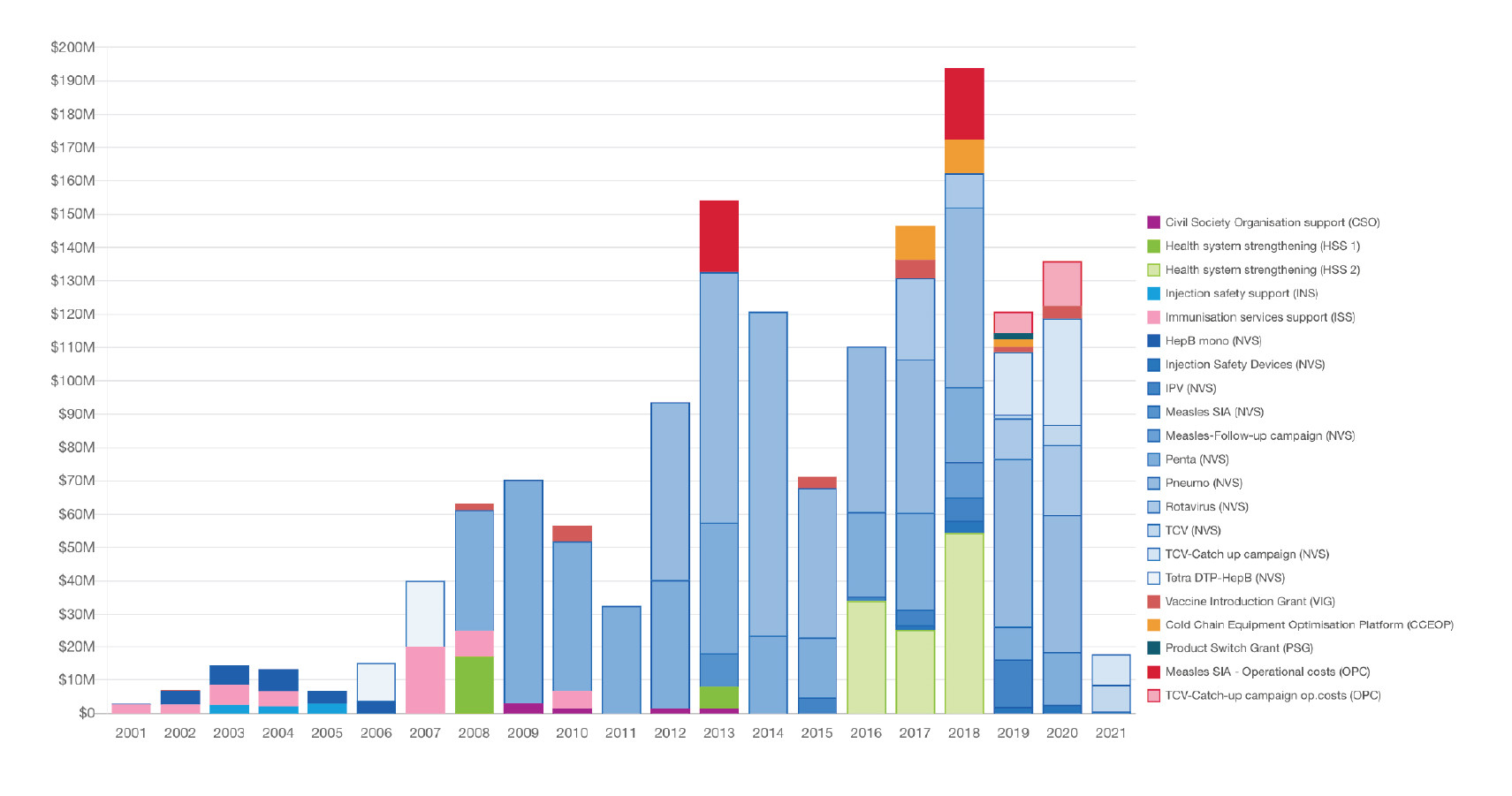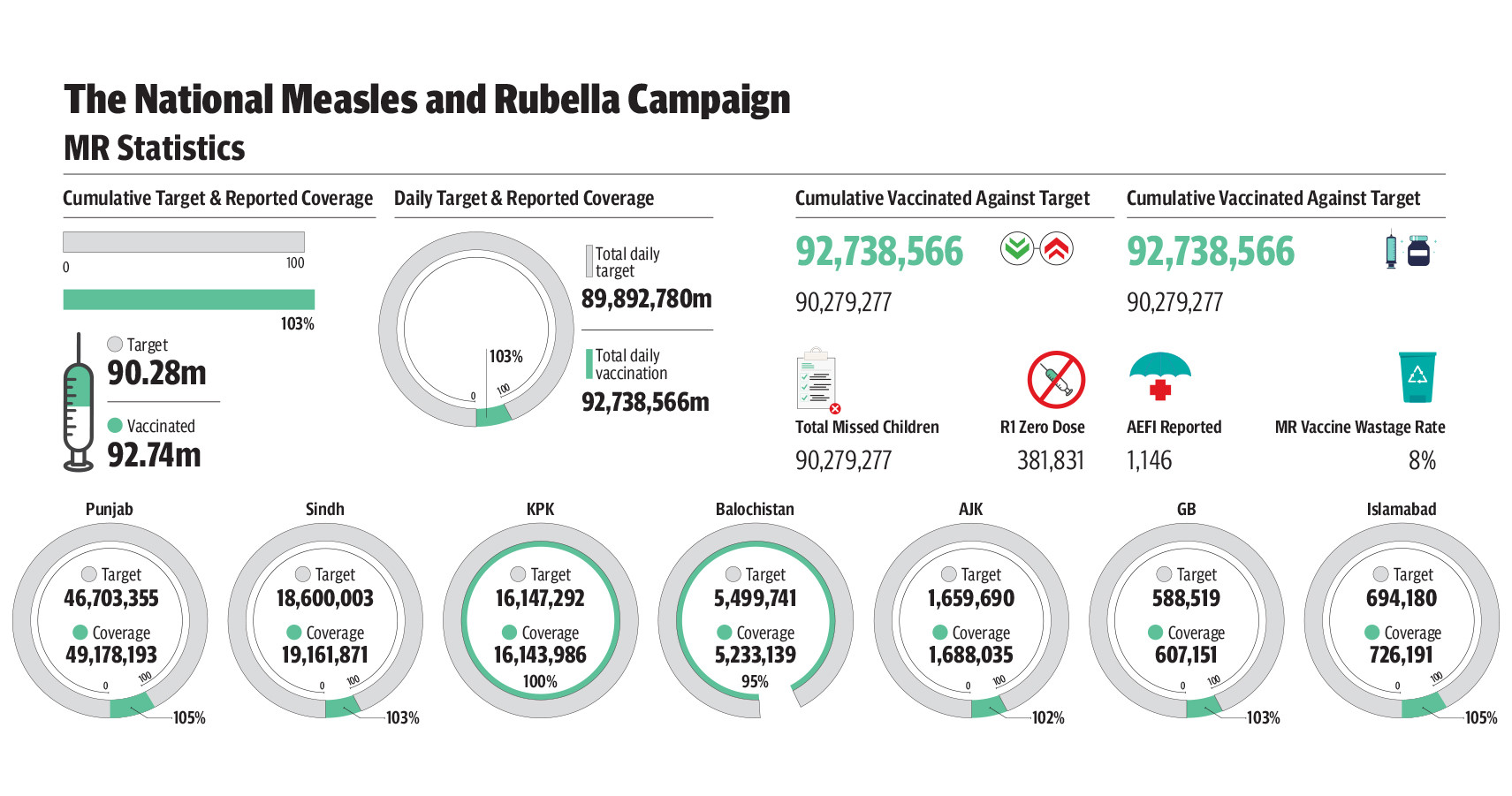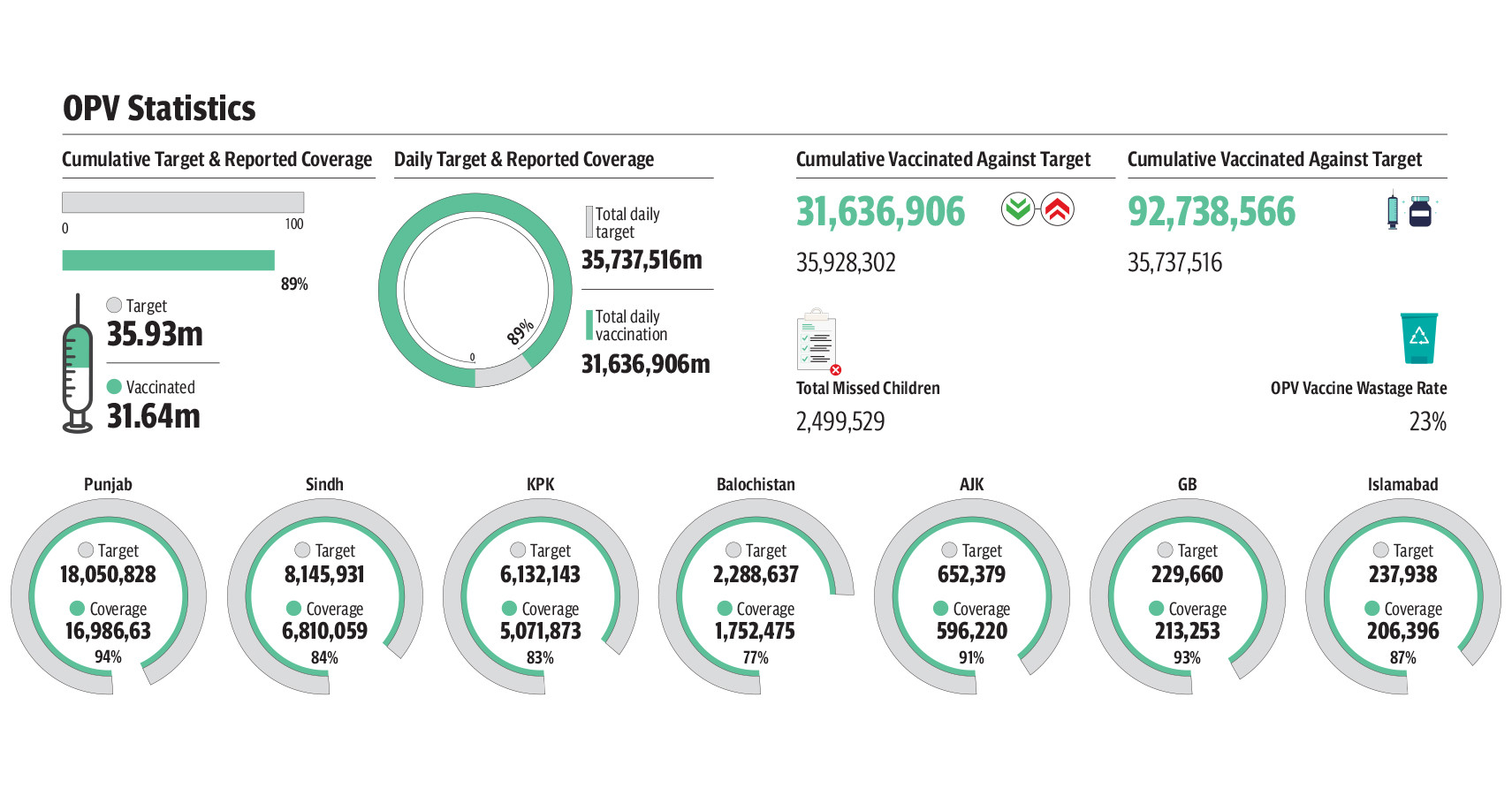The novel coronavirus pandemic has unleashed untold death and chaos around the world. One would think, craving normalcy, people would be rushing towards a cure when one was announced. Yet, those peddling misinformation and distorted facts have hijacked the narrative around inoculation. The result: many around the world remain resistant to getting vaccinated, going so far as to even protest against measures aimed at keeping the world safe.
But while Covid-19 grabs much of the anti-vax spotlight, it is not the only inoculation drive to face resistance. In Pakistan, efforts to eradicate polio remain challenging, with the diligent workers who administer vaccines often risking their lives while performing their duties. Resistance for other vaccinations such as measles isn’t as high as they are provided by the hospitals to the children at the time of birth till the age of two years where parents still have the same faith as they feel it can help build better immunity of their children. But even then, a majority of parents still don’t get their children vaccinated with these shots and as a result the children face severe illnesses and it results into larger outbreaks.
To control the spread and prevent such outbreaks the government of Pakistan decided to carry out a large-scale drive to vaccinate children between the ages of 9 months to 15 years for measles and rubella (MR) vaccines.
National MR campaign

Rather late and behind several countries but the federal government finally devised a plan to start a ‘The National Measles and Rubella Campaign’ and contacted the vaccine alliance, GAVI for their help in this regard.
With the provision of vaccines and cash support, GAVI, UNICEF, WHO, and the government began a 12-day nationwide immunization drive in which, 92.75 million children were vaccinated. “The idea was to reach out to as many children as we can to prevent the deaths, which might be caused if the outbreak is not controlled,” Dr Seth Berkley, the CEO of GAVI told The Express Tribune.
Both measles and rubella can be responsible for a huge number of deaths if vaccinations are not administered at the correct time. “The 12-day long drive has vaccinated millions of children aged between 9 months to 15 years,” said Dr Berkley, who was on a visit to Pakistan to keep a close eye on the immunization drive.
“Measles and rubella can only be controlled by vaccinations and we want more and more people to step out and bring their children to get jabbed,” he said, adding that the drive included education, health and social sector to help and cover as much of the population as possible.
The vaccine is the first of its kind in the country to help people and the target is mainly rural areas where access to health care is not as good as urban areas. “We tried to target as many people as we can and if we achieve the number that we are hoping to achieve then it's easier to prevent [these deaths],” the CEO said who has been making rounds of vaccination centres to monitor the driver himself.
The vaccination drive includes vaccines and the operational cost, which was funded by GAVI but operational work has been done by the government on national and provincial levels from social mobilizers, health workers and engaging schools to vaccinate children. “As health and education is a provincial subject and authority in Pakistan after the amendment in the constitution so the drive needs to be operative accordingly where we aimed to go to schools and vaccinate children,” he shared. Children usually spend half of the day in schools and half of the immunization drive time can be wasted keeping in view the school so they came up with the idea of starting the immunization drive in schools as well.
Facts and figures

Multi-year programme budgets endorsed by GAVI board
Researches and many reports in previous years have shown a prominent drop in numbers of predicted deaths due to such outbreaks. Similarly, Pakistan has on record 9,000 cases in 2020 and was expecting almost 18,000 cases of measles and rubella in 2021, and casualties caused by measles would be more than 150.
“Such vast immunization drives can help in preventing such outbreaks and if any country has 85 to 90 per cent of vaccination coverage then only is it in the safe zone. Even with Pakistan such massive drives are needed after every four to five years that can only help to control the situation or else the medical system can fail and collapse,” Dr Berkley explained, adding that the reason behind such big numbers to be expected of measles and rubella is because since Covid-19 has hit the world the whole focus has shifted on that and many countries have stopped thinking what other vaccines and diseases can grow along. “The drive was due in Pakistan for a long time but got delayed due to the Covid-19 situation with the travel ban, lockdown situation, restricted movement but if we had waited more then the outcome could be disastrous,” he added.
The drive was fully funded by GAVI from providing vaccines, to cold chains, logistics, mobilizing the community, and making it accessible on the ground level. “The whole immunization drive cost 150 million US dollars which included vaccines and cash support,” said CEO GAVI. The entire drive included 380,000 health professionals, 76,000 vaccinators, 143,000 social mobilizers in the nationwide vaccination drive for measles and rubella.
Zero dose of MR

Since there was previously no MR vaccination in Pakistan, it was anticipated that many would be reluctant to get the vaccine. Therefore, before the drive began, social workers were sent to many communities to educate them on the importance of the vaccine. This awareness campaign included educating the communities but efforts were also made to identify and narrow down those people who were still on the fence about the inoculation. Those reluctant to get their children vaccinated were further explained about the benefits of the vaccine and the negative consequences of an outbreak if the vaccine wasn’t availed. However, many parents having seen people die from measles in their locality, didn’t need much encouragement to bring their children for the inoculation.
Children whose shots were administered in a school were expected to get a signed consent form from their parents while the ones getting vaccinated at home did not need that.
Country coverage
The country's average vaccination coverage came to 80 per cent in total with Baluchistan having 43 per cent coverage and Khyber Pakhtunkhwa 49 per cent. “People treated measles and rubella vaccines differently than how they treat polio drops as they do not see people dying of that, even in rural areas of Baluchistan people were bringing their children in for getting shots which was a happy moment overall,” he said while sharing his personal experience from vaccination camps.
“One can’t rule out the idea that they we will never face the outbreak as no one ever thought what damage Covid-19 can be to the world a few years ago. Similarly, India started working on such vaccines for measles and rubella and they have also been doing the vaccination drives in phases to cover a good percentage to prevent casualties,” he said explaining how Asian countries are dealing with such diseases.
While this one-time drive cannot resolve eradicate these diseases altogether in the country, it can certainly help contain the problem to a large extent and give the government a chance to create and implement a long-term strategy on both a legislative as well as administrative level that can have lasting benefits for future generations. Previously, Pakistan’s MR and Rubella vacation coverage was previously only 60 per cent however, the drive has helped boost it to 80 per cent to help the country such as Pakistan which was on 60 percent of vaccination coverage, such drives can boost it to 80 percent thus proving that such drives are needed every four to five years.
What parents think
One overriding concern on the lips of every parent approaching social workers were the possible side effects of the vaccine. Since this vaccine was the first of its kind in Pakistan, there was a sense of apprehension as its side effects remained unknown. As is with any new vaccine and disease, there are also the accompanying conspiracy theories, which remain unproven but strike enough of a fear to raise a resistance to get the vaccine. This was observed across the world with the coronavirus outbreak and its resulting vaccine. However, according to Dr Berkley, there are no known side effects of this vaccine. “These are all are one-shots vaccines but to be on the safe side, we suggest two shots of measles as we have a 5 per cent rate of children who do not respond to the shots so we want to make sure the shot has been administered to all those whose bodies didn’t respond to the first dose,” he said, adding that the second shot would be eligible after 18 months of the first dose.
However, despite the scientific data supporting the use of vaccines and the awareness campaign carried out through community engagement for building trust in vaccines, there is still a specific section of people who do not believe in the idea of vaccination and think that the government is manipulating them into injecting something harmful. “I never had polio drops or any other vaccine in my life and I never let my children have them too. I don’t think children need any immunity booster as they already have immunity to fight such diseases. They are born with them and such government tactics are just to confuse people,” shared a parent who refused to sign the consent form sent from the school. She also added that even with the Covid-19 vaccine, she and her husband didn’t get vaccinated until their office demanded or their children’s school administration asked them to.
Another worried parent has been talking to several parents and relatives to make them understand the importance of vaccination and how people who are anti-vaccinators can be dangerous to others as well. “It is so difficult to put sense into some people that their child might be strong but not everyone’s is and their child can transfer the disease to others but despite awareness campaigns where the government is spending a lot to educate people, still deep-down people are reluctant to get shots,” said Sidra Ali who is a mother of two and is trying to spread awareness through her social media. She also said that the recent immunization drive was a great initiative by the government but they should have also projected it well with more engagement of the locals and religious public figures as people might not listen or follow politicians, celebrities or any other public figure but religious figures have a following of millions and people listen and follow them, and adding them to the campaign can help in portraying a better message to the masses.
“The idea of vaccinating children at schools is commendable as schools are the best way to educate not just children but parents as well,” shared Farhan Butt, who is a father of two sons. He also said that the schools didn’t send a form but texted them to inform them about the vaccination drive and asked for consent. “At first we thought it was some Covid-19 vaccine but then when we talked to the school administration, we learned that MMR is for Measles and Rubella which again can help us fight this disease,” he added.
During the 12-day drive, GAVI not only administered MR vaccines to children but also promoted and encouraged polio vaccines. According to the data shared by GAVI officials, during the 12-day drive, 31.64 million children were also vaccinated against polio.
How provincial govt helped

The success of the massive drive was largely due to the fact that all skaeholders were on the same page. Provincial governments also participated in helping to carry out the drive successfully by being present on the ground and formulating micro plans to deploy teams. “When UNICEF, WHO, and GAVI came on the ground to discuss how to implement the drive, we suggested to them to incorporate the EOC, polio workers, deputy commissioners, immunization ADC1, DEOs, and local focal persons to help to interact and to arrange what is required,” said Sindh Parliamentary Secretary for Health Qasim Soomro.
The vaccination drive was not an easy task with Sindh alone aiming to vaccinate 18.6 million children exceeding with upto 19.8 million vaccinations in total. “There were around 100,000 workers involved in the whole procedure from vaccinators to health professionals. This also includes 1,000 supervising doctors and 500 pediatricians,” shared Soomro. Other than these workers, the police, rangers and the army was also present to help and make the process smooth and to counter any mishap if they occur.
The province of Sindh itself had faced an outbreak last year with thousands of cases evolving in a few districts which had jolted the provincial government into springing into action. In 2020, Jacobabad, Shikarpur, Hyderabad, Larkana and adjoining areas reported an outbreak of measles with cases around 5,000 and 38 casualties thus raising alarm and making them realise that such a vaccination drive was pressingly needed. “It was commendable how all the stakeholders and both the federal and provincial governments were on the same page for this drive and made it a success with hard work,” said Soomro.
Vaccination drives happen in routine all the time around the globe but this specific immunization drive was the world’s biggest and there were several reasons why this was much-needed in the time when the country is already fighting Covid-19 and the health sector is engaged in Covid-19 vaccination drive. “There were two main reasons why this drive was need of the time: firsly, the number of cases had shot to thousands from not even 100 and secondly, more than 10,000 suspected cases were reported after surveying hospitals in the last one year,” said Muhammad Akram Shah, National Programme Manager-Extended Programme on immunization (EPI) Pakistan.
The reason for such a sudden outbreak was that the health sector has been occupied in Covid-19-related management and routine vaccines were not getting administered properly, which is why in the first few months of 2021, 71 cases were reported and outbreaks started. Many areas of KPK and Baluchistan, while 18 districts of Sindh were badly hit. “Suspicion of rubella is never the first thought when any case comes in but we always test for rubella once the measles test comes out negative since they both have almost the same symptoms and we don’t have much awareness about the disease itself,” he explained.
After the measles outbreak, the government began surveillance in eight hospitals from where when they monitored the 10,000 suspected cases of rubella and it was decided to carry out such a massive drive. “It was a new cohort and starting just a regular vaccination through hospitals alone could have taken a long time and we didn’t have time or else the outbreak could have been worse. From January 2022, routine cohort will start and children will start getting vaccinated and then after four years, we will have another such massive drive to cover the possible masses,” Shah said.
With many factors, masses were not a reluctant for MR vaccines as the threat perception was there as they have seen mortality and hospital with such cases. “There is no Urdu name for rubella also the other name could be German Measles but we thought to use rubella itself or else people will fear that some new virus has come,” he said, adding that people still kept asking questions but the department was clear and told them how children who are having abnormalities since birth are due to their mothers having rubella and weren’t vaccinated as kids. “Schools were fearful of the idea that they would get attacked or any there would be incident of students fainting, which could sabotage the drive but nothing like that happened and the drive covered 41 per cent of the total population,” said the national programme manager.
What vaccines should be administered?
Currently, the existing healthcare system already provides a majority of vaccines free of cost for children upto the age of six at all government and private hospitals. The private hospitals charge a nominal fee for administering the vaccines while in government hospitals that are even free. “Influenza vaccine is one of the vaccines which is not free of cost and is one of the costly ones, which is usually administered after the age of 12 months and the [cost of the] vaccine keeps revising every year, which is why it is difficult to provide it free of cost and also the symptoms are mild and [the disease] is not fatal,” said the former special assistant to Prime Minister on health, Dr Zafar Mirza. According to him the government is considering broadening the number of vaccines they provide free of cost. “Among many other currently Human Papilloma vaccine is under consideration to be included in free vaccines or at minimal cost as the price is under negotiation as it is a major cause for cervical cancer,” he said.
According to the US’s Centre for Disease Control and Prevention (CDC), children should get are Varicella (Chickenpox), DTaP (Diptheria), Hib, HepA (Hepatitis A), HepB (Hepatitis B), Flu vaccine (Influenza), MMR (Measles), MMR (Mumps), DTaP (Pertussis), IPV (Polio), PCV13 (Pneumococcal), RV (Rotavirus), MMR (Rubella) and DTaP (Tetanus) vaccines. From this list, chickenpox, HepA, PCV13, and influenza are the ones which parents have to buy themselves and then can get their children vaccinated from any hospital. “The vaccine which we had to buy cost us around 3,000 to 7,000 for different vaccines and all these were given after the age of one before that all vaccines were free of cost,” said Nimraah Jamil who is a mother of a two-year-old.
Unlike Pakistan, there are several countries that have influenza and other vaccines available for free however, there are many others which do not provide them. “Keeping in consideration the intensity of the disease and how it can affect the masses, the government has several plans to include many vaccines to build a better health sector,” said Dr Mirza, adding that the reason for this massive immunization drive was also to increase the immunity of children as the world has seen few outbreaks in recent times and it could be difficult to manage for Pakistan when the country is already suffering from Covid-19.
